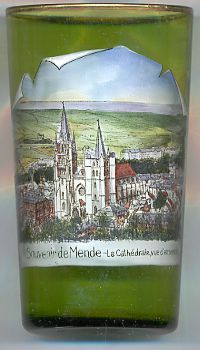

|
| FRANCE | FRANCE |
| région: Occitanie | |
| département: 48, Lozère |
 Mende is situated at an elevation of 732 m on the left bank on the river Lot in the southern part of the Massif Central in the
région Occitanie in southern France. Mende is the capital (préfecture) of the
département Lozère. The municipality has a population of about 12,600 (2005).
Mende is situated at an elevation of 732 m on the left bank on the river Lot in the southern part of the Massif Central in the
région Occitanie in southern France. Mende is the capital (préfecture) of the
département Lozère. The municipality has a population of about 12,600 (2005).
The oldest remains of human settlements in this place date from about 200 BC. In ancient texts the name Mimate or Mimata designated the village at the foot of Mons Mimatensis, today Mont Mimat. It is quite certain that it was the village that gave the name to the mountain. The town proper was first mentioned at the end of the 6th century, in the 'Histoire des Francs' of Grégoire de Tours, a text that refers to St. Privat (d. 255 or 260), the first bishop of the region. In 1161 Mende became part of the kingdom of France, and the bishops obtained sovereign privileges. Nevertheless, Mende was not the capital, neither civil nor religious, of the Gévaudan region (almost exactly the modern département Lozère). In effect, it remained dependent on two powers, the counts and the viscounts of Grèze. The title of viscount, originally in possession of the kings of Aragon, was obtained by the kings of France in 1258. During the French revolution, Mende became one of the capitals, together with Marvejols, of the département Gévaudan which was renamed Lozère in 1790. The secular rule of the bishops was abolished in 1791, ending the coregency which had started in 1307. The préfecture of the département was dinally established in 1800.
The  cathédrale Notre-Dame et Saint-Privat was founded in 1368 by Pope Urban V. The towers originated in the 16th century.
The taller of the two towers once held the "Non Pareille", cast between 1517 and 1521 in Villefort, at the time the world's largest bell, which was destroyed during the
French Wars of Religion (1562–1598). The cathedral is composed of twelve rectangular chapels and twelve chapels with apses. The crypt is the burial site of
St. Privat, and is one of the oldest crypts known in France (3rd century). The church was classified as a historical monument in 1906.
cathédrale Notre-Dame et Saint-Privat was founded in 1368 by Pope Urban V. The towers originated in the 16th century.
The taller of the two towers once held the "Non Pareille", cast between 1517 and 1521 in Villefort, at the time the world's largest bell, which was destroyed during the
French Wars of Religion (1562–1598). The cathedral is composed of twelve rectangular chapels and twelve chapels with apses. The crypt is the burial site of
St. Privat, and is one of the oldest crypts known in France (3rd century). The church was classified as a historical monument in 1906.
![[scale]](lineal.jpg)